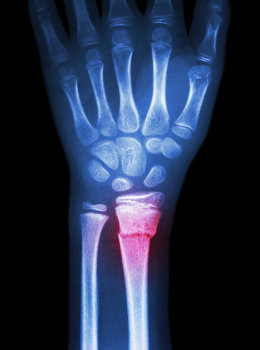Need more information regarding a hairline fracture? Read this article to enlighten yourself about doing the right thing when encountered with a hairline fracture...

Hairline fractures are often a common occurrence in sports and athletics. They are also called stress fractures, and usually happen due to sudden or continuous exertion of force over a particular area (often the ankles and wrists), leaving it bruised or with a slight crack on the bone. It is usually foreseen as a tiny crack in the bone, the size of a hair strand, and hence the name. It mainly occurs on those bones which bear a lot of weight.
Causes
The bones in our body are always in the process of repairing and remodeling themselves, and new cells consistently take shape. A hairline fracture commonly occurs when a person exerts too much pressure on his lower bones. If the force exerted on the bones result in more impact than the regular pressure it can bear, the capacity of the bones to repair themselves and regeneration of tissues gradually deteriorates, resulting in incapacity or weakness in that particular area. Slowly, appearances of a stress fracture become prominent along the bone through swelling or bruising. These fractures however, do not appear suddenly like compound fractures, as they are formed over time and develop with repeated tension on the particular area.
Fatigue in the muscles is also another cause for stress fracture. The bones and muscles are responsible for absorbing the pressure that is exerted when a person is subjected to any physical activity. However, running over long distances causes the muscles to be fatigued and tends to fail in absorbing the impact of stress on it. Continuous stress on the area due to respective body movement results in what we know as a hairline fracture - the first phase.
Symptoms
Unlike other bone fractures, stress fractures are not that obvious. A person can be totally unaware about it, at least initially. Gradually, the fracture develops prominently due to repeated limb movement. If ignored, over time, the fracture what starts out as a hairline can result in dislocating of the joint and tearing of tissues, also leading to severe repercussions like infections and other bone related issues. In order to prevent this, it is important that one knows the various symptoms, so that treatment that can be commenced immediately. The symptoms are as follows:
- Swelling and mild inflammation along the area that is affected.
- The area exudes pain when pressure is exerted on it, but, when left motionless for sometime, the pain ceases.
- One particular part of the bone feels tender or sometimes very painful when touched.
- Numbness around the bone and tingling sensation upon movement.
- Abrupt clenches during movements.
- The area turns blue and black in dire circumstances.
- Difficulty in bearing weight on the particular area.
- Deformity of the limb which has the stress fracture.
Treatment Options
An immediate X-ray needs to be done, followed by adhering to regular follow-ups at the doctor. Rest, rest and more rest... that's one of the best remedy for most fractures, as the affected bone tends to strengthen over time with appropriate recuperation. The period of healing depends on where the fracture has taken place, how severe it is, and also in accordance to the person taking good care of himself and giving time for the fracture to heal. The period of complete rest might vary from 5 to 6 weeks, depending on its location and severity. If the fracture is severe, then the patient is asked to prolong the rest duration for at least 10 to 15 weeks.
Initially, an ice pack is rolled along the swelling to reduce it. If the situation is severe, then a cast might be used temporarily to restrict movement and reduce stress along the area. If any complication still exists, an MRI scan is done to determine intricate details of the injury, and is further treated appropriately through surgery, if needed. Calcium and protein intake in food is ideal as it supplements strength to the bones.
I recently developed an uncanny hairline fracture on the wrist due to a minor accident and ended up sporting a horrid cast for a month. The bone of contention wasn't very becoming. The doctor now suggests a surgery to alter the dislocation and damage on the wrist bone, as I had neglected it for quite sometime. I strongly urge anyone with similar problems to get it shown at the earliest and avoid the grueling ordeal of being confined to a cast or going through a surgery for the same.


 Hairline fractures are often a common occurrence in sports and athletics. They are also called stress fractures, and usually happen due to sudden or continuous exertion of force over a particular area (often the ankles and wrists), leaving it bruised or with a slight crack on the bone. It is usually foreseen as a tiny crack in the bone, the size of a hair strand, and hence the name. It mainly occurs on those bones which bear a lot of weight.
Hairline fractures are often a common occurrence in sports and athletics. They are also called stress fractures, and usually happen due to sudden or continuous exertion of force over a particular area (often the ankles and wrists), leaving it bruised or with a slight crack on the bone. It is usually foreseen as a tiny crack in the bone, the size of a hair strand, and hence the name. It mainly occurs on those bones which bear a lot of weight.